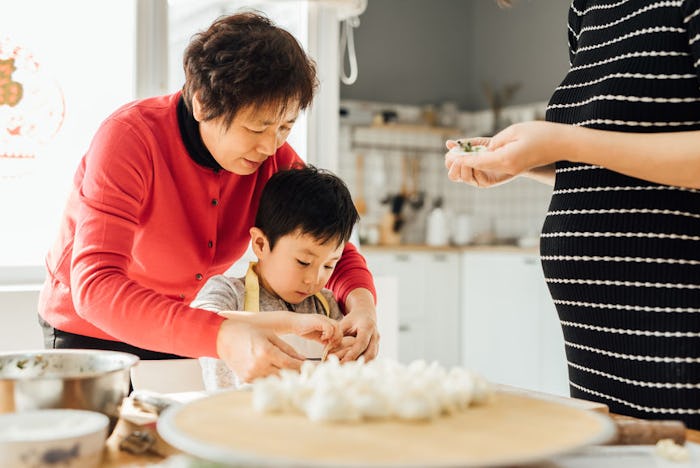Life

These 6 Signs Mean Your Kid Is Ready To Use A Knife To Cut Their Food, Yikes
It started off with your baby sticking a spoon in their mouth and drooling all over it. Then, that baby transformed into a toddler and started spearing soft cheese with a fork. And just when you thought you’d mastered mealtime mayhem, your elementary-aged kid uttered the dreaded words: “I want to do it!” and insisted on cutting their food — all by themselves. For sure, it’s a conundrum. You don’t want to spend the rest of your days chopping up chicken, but you don’t want your kid to go slicing and dicing their finger off, either. It can be hard to know the signs your kid is ready to use a knife to cut their food so that they'll be safe in the kitchen.
All things considered, when your child is ready to be independent at the table, it’s a rite of passage. You just don’t want said rite to head you right to the emergency room, though, with a severed tendon… or worse.
“It’s important for your child to understand that a knife is not a toy,” says Leigh Ann Chatagnier, a chef and food blogger. While you want to stress caution and care while using a knife, you don’t want to scare your child so much that they wind up impaling themselves, either. That’s why getting kids into the kitchen sooner rather than later can help them develop not only a respect for kitchen safety but also a love for cooking. Look for these cues the next time your kiddo wants to use a knife to see if they’re ready or not.
1They've shown a willingness to learn
Knife readiness is really all about ages and stages. You can have a very mature 5-year-old who might be able to cut a pineapple, and on the other hand, the thought of your 10-year-old wielding a knife might make you cringe. According to the American Knife & Tool Institute, no matter what age you decide to let her use a knife, you should always, always, always supervise your child. What’s key is her ability to listen and follow detailed instructions: If she’s observant and eager to understand how to use a knife, those are positive signs.
2They're calm in the kitchen
The Chicago Tribune reported that having a good sense of her temperament should be one of the first steps in deciding when your child first uses a knife.
If she’s cool as a cucumber, that probably means she’ll be able to handle herself with a knife. But if she’s easily distracted, then it might be best to wait a while until she’ll be more responsible.
3They've practiced before
Ideally, your child has had some previous experience handling a knife. Whether it was a plastic one used to cut her hot dog in half or even fake fruit that split apart when using a toy knife, she should know what one feels like in her hands.
“I suggest starting easy chopping tasks around age 2,” says Chatagnier. “This is a great way to get kiddos involved in food prep.” To get started, younger kids can use a butter knife to cut soft foods, such as bananas or avocados that have already been de-pitted and scooped out of their shells.
4They're not afraid
The last thing you want to do is stick a sharp knife in the hand of a skittish kid. If your child is confident and feels like she can handle it, you can probably be assured that she’s probably not going to panic if you ask her to cut up some strawberries or hard-boiled eggs. To offer additional reassurance, set up a cutting board for her right next to yours so that you can chop away together. That way, she’ll feel like an important part of the meal preparation, and not like the spotlight is on her and her knife skills. And be sure to praise her for culinary contributions, even if her cuts aren’t exactly ideal.
5They've shown interest
Maybe it’s because she’s a huge fan of Chopped Junior. Or maybe it’s all those times she’s spent sitting watching you in the kitchen while you cooked dinner that’s piqued her interest and that’s why she wants to take her food skills to the next level. If your child has directly asked to learn how to use a knife, you shouldn’t let your fears stop her. Encourage her interest by buying her an age-appropriate knife and give her tasks that she’ll be able to perform safely.
6They have good hand-eye coordination
A clumsy kid and sharp kitchen tools do not a good match make.
“It’s important to teach proper hand placement so that kids know that they need to keep their fingers away from the blade at all times,” says Chatagnier.
The goal, after all, is not for your child to hack-saw her way through a melon rind on her first try. Start with foods that are flat as opposed to round, so that you avoid the risk of the slippage — and the knife skewering your child’s hand. And above all, help your child practice patience. Knife skills are developed over time.
7
Handing over a knife to your child might feel like you’re giving your kid a deadly weapon to wield. But with proper training, a lot of encouragement and love, using a knife will be just one more skill in the books.
This article was originally published on